
Newly Diagnosed GBM
Designed to extend survival in ndGBM1, 4
Since 2005, EF-14 is the only positive phase 3 trial in GBM.19
The trial included 695 patients with newly diagnosed GBM1,3,20
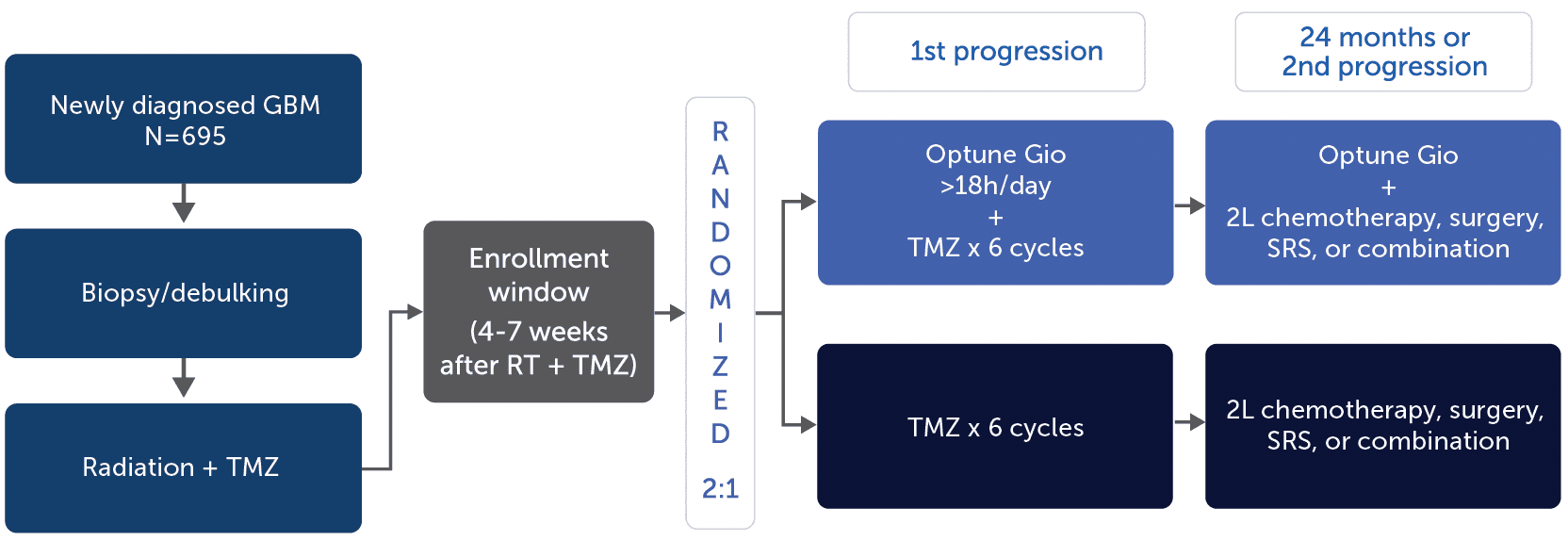
Efficacy endpoints1,20
- Primary endpoint: PFS, assessed centrally
- Powered secondary endpoint: OS
- Additional secondary endpoints: PFS6, 1- and 2-year survival, QoL, radiological response rates
Key inclusion criteria1,3
- Underwent maximal debulking surgery and radiotherapy concomitant with TMZ
- KPS ≥70
Key exclusion criteria1
- Progressive disease per Macdonald criteria, following concomitant chemoradiation
- Implanted electronic medical devices
- Significant comorbidities at baseline that would prevent maintenance TMZ treatment
- Infratentorial tumor(s)
Optune Gio can be continued past first progression1
Give your newly diagnosed patients the best chance at extending survival1, 3
As part of your treatment approach, incorporating Optune Gio with other available options such as surgery, radiation, and TMZ can contribute to redefining your patients’ treatment results1,3
Based on EF-14, incorporating Optune Gio into your treatment paradigm may add nearly 5 months to median overall survival (P<0.001).1,3
Overall survival (5-year survival analysis)1,3,6
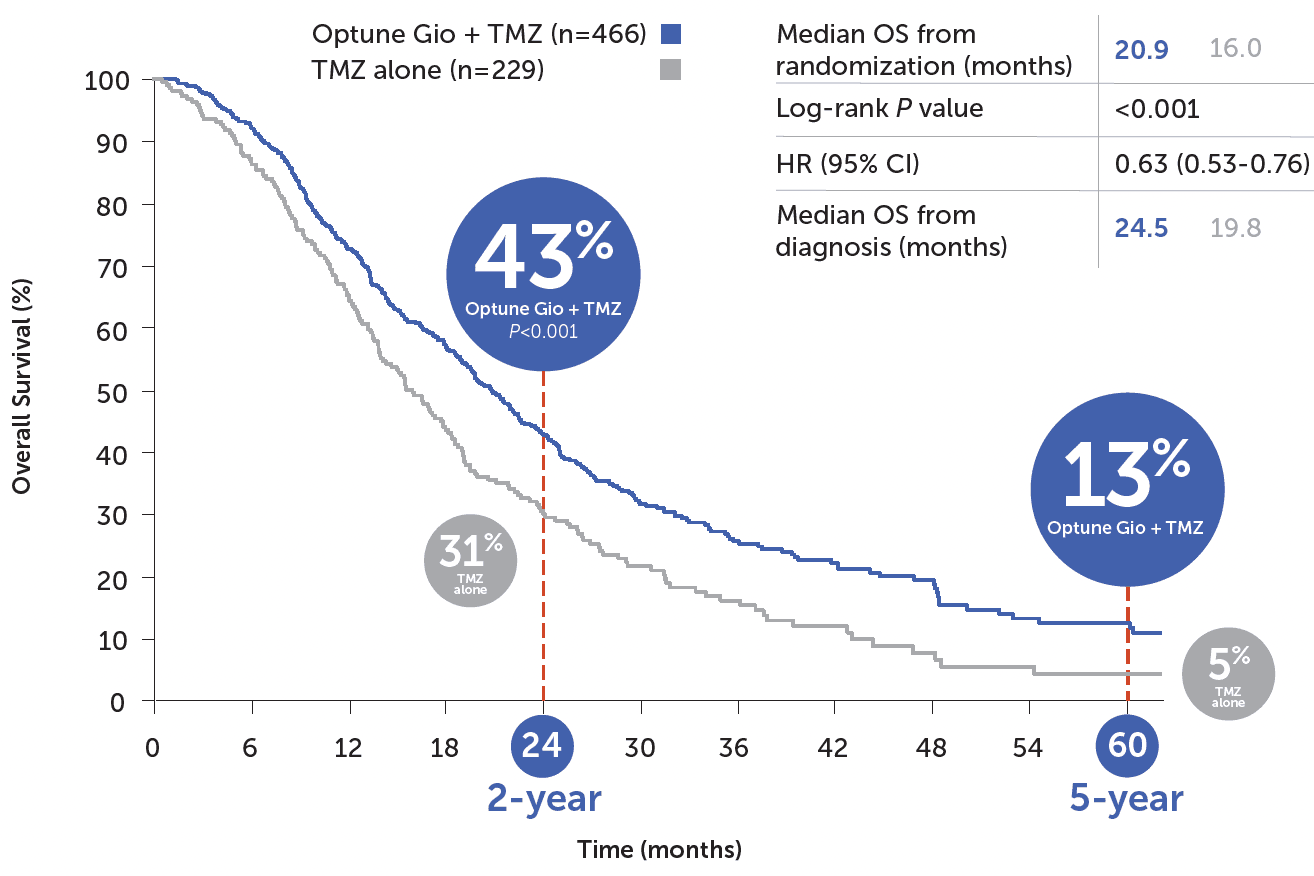
Optune Gio + TMZ also significantly improved PFS vs TMZ alone1,3
- Median PFS: 6.7 months vs 4.0 months (P<0.001)
Offer your patients a 2 year post diagnosis median OS benefit by using all 3 tretaments1,3,6
More time on Optune Gio predicted increased significant survival benefit21
Monthly usage was a predictor of survival benefit, independent of other prognostic factors, such as KPS, age, or MGMT methylation status‡
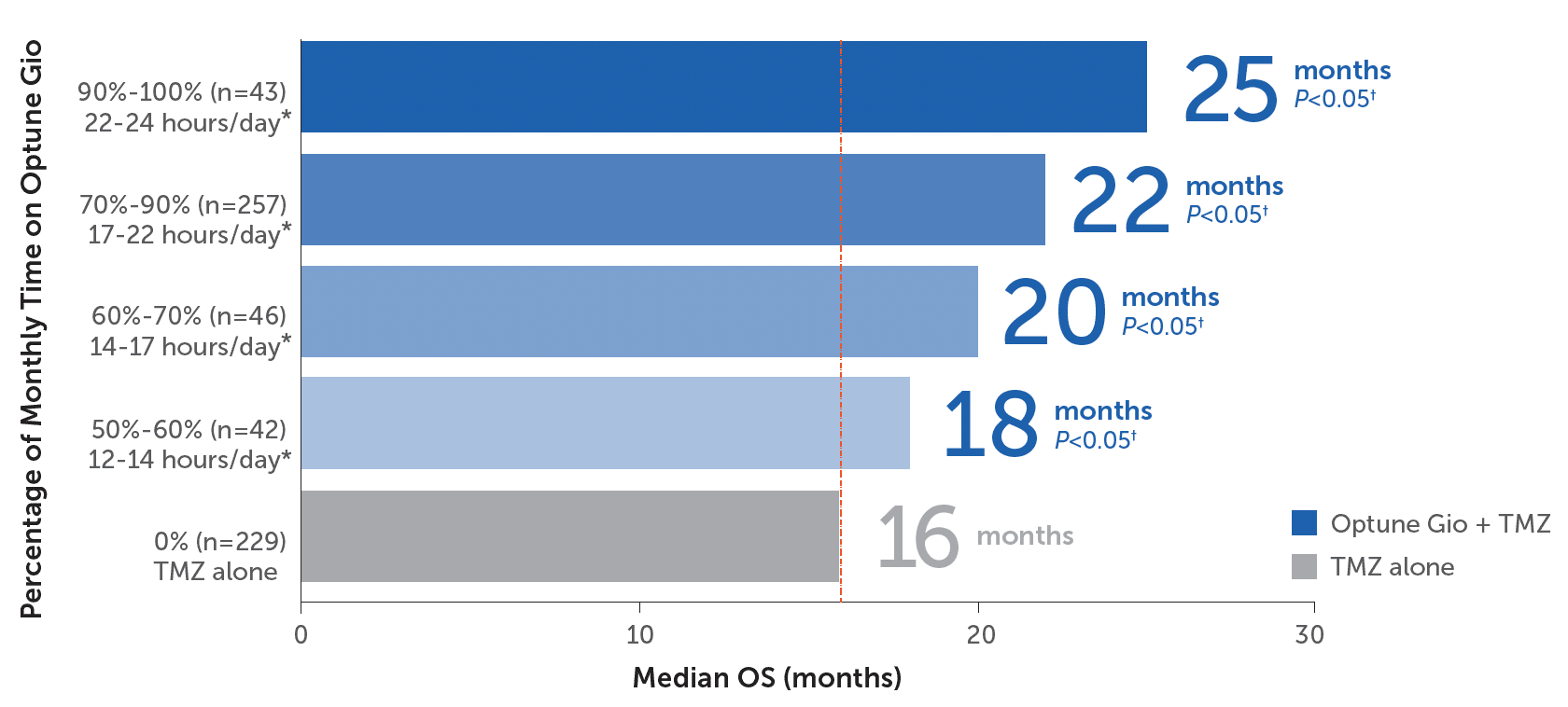
Efficacy in elderly patients
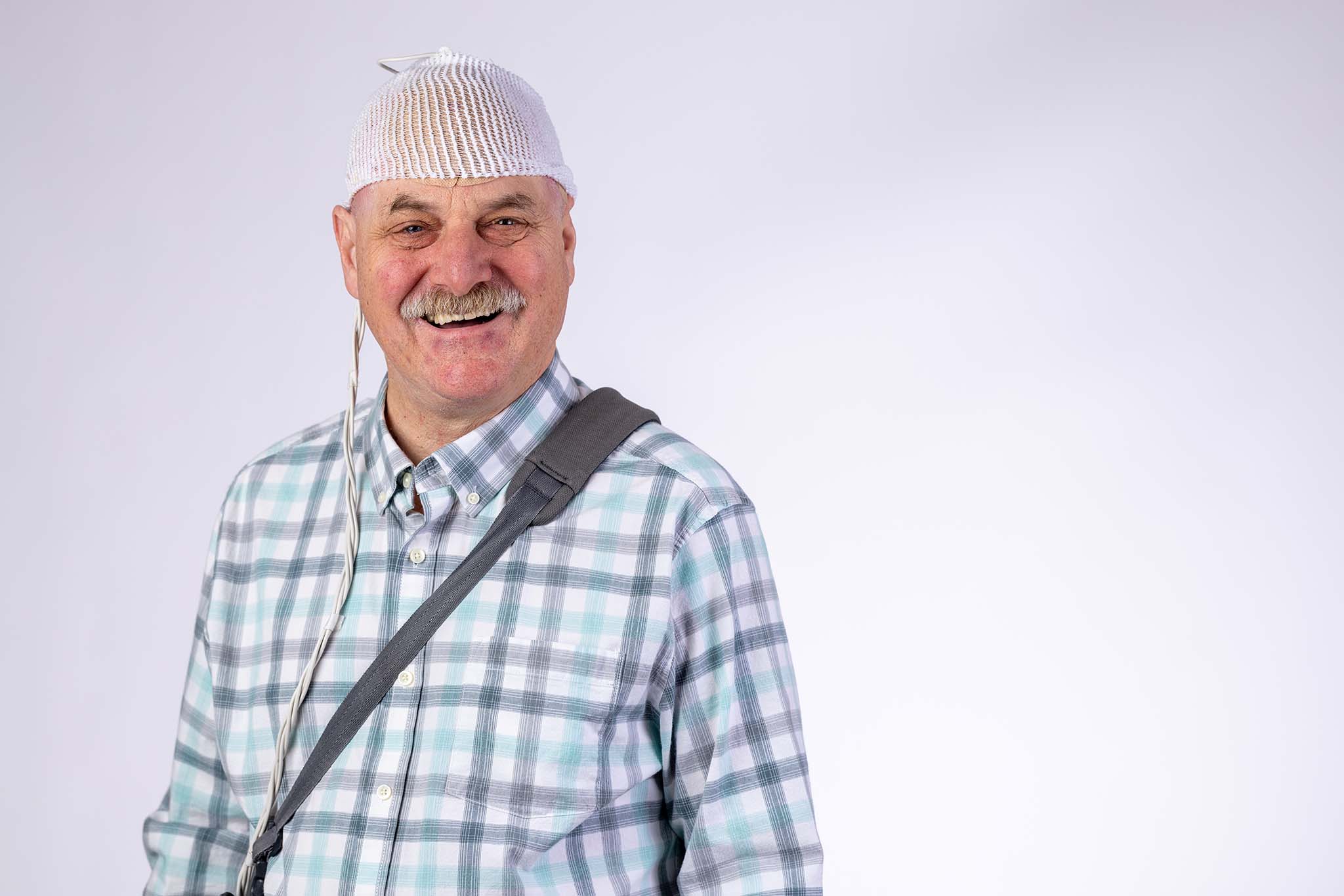
Scott is an Optune Gio user and Patient Ambassador. Patient images reflect the health status of the patient at the time each photo was taken.
In newly diagnosed GBM,
A post hoc analysis of the EF-14§ study demonstrated that Optune Gio + TMZ was associated with increased survival in elderly patients22
OS in patients 65 years and older
- This post hoc subgroup analysis included data from all 134 patients 65 years of age and older in the intent-to-treat population and compared OS, PFS, and safety between the 2 treatment arms: Optune Gio + TMZ (n=89) vs TMZ alone (n=45)
- Patient baseline characteristics and known prognostic factors were balanced between the 2 treatment groups
- Median patient age and KPS were 69 years and 90, respectively
- Survival rates for patients 65 years of age and older were consistent with the overall trial population
Optune Gio + TMZ in elderly patients showed no significant increase in AEs
- No significant increase in systemic AEs in patients treated with Optune Gio + TMZ (46%) vs TMZ alone (40%)
- SAEs were reported in 39% of patients treated with Optune Gio + TMZ and in 33% of patients treated with TMZ alone. None were considered related to treatment with Optune Gio
- The rate of grade 1 or 2 medical device site reaction was 51% for Optune Gio + TMZ compared with 0% for TMZ alone, and severe (grade 3) skin involvement occurred in 2% of patients treated with Optune Gio + TMZ
Optune Gio + TMZ was also associated with improved PFS vs TMZ alone in elderly patients
- Median PFS: 6.5 months vs 3.9 months; HR: 0.47 (95% CI, 0.30-0.74)
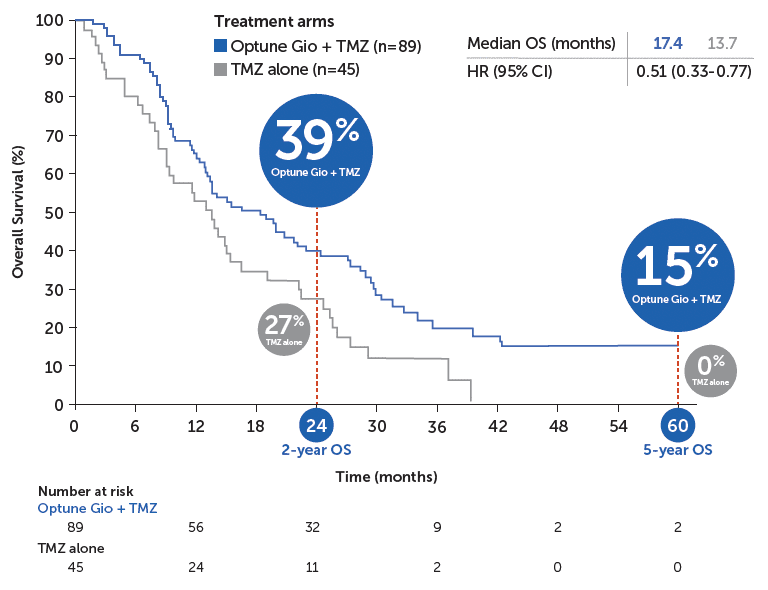
Consider Optune Gio as an option for your patients over 65
Efficacy in patients with biopsy only
In newly diagnosed GBM,
A post hoc analysis of the EF-14§ study showed Optune Gio + TMZ was associated with increased median OS vs TMZ alone in patients ineligible for surgical resection3
The EF-14 pivotal phase 3 trial included patients with newly diagnosed GBM who only had a biopsy3
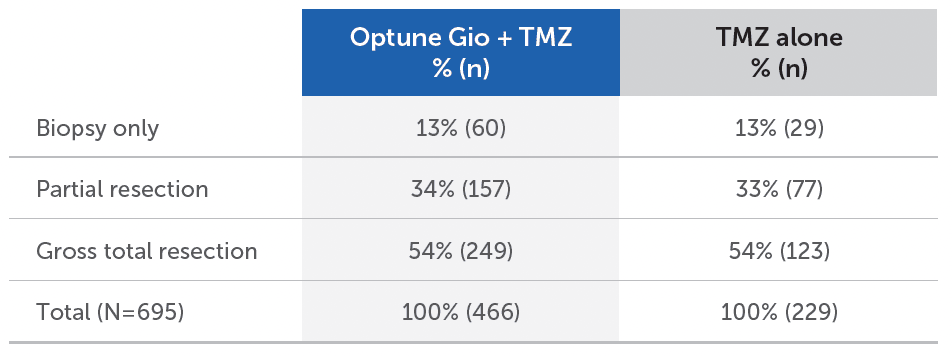
- The study protocol defined surgery as surgical resection to the extent safely feasible or biopsy3
- In the EF-14 trial:
- 13% of patients in each study arm only had a biopsy3
- 3 patients treated with Optune Gio + TMZ and 1 patient in the TMZ alone group were included in the analysis at 48 months6
Patients with biopsy only are especially vulnerable to progression—help protect them with Optune Gio6
Overall survival in patients with biopsy only (5-year survival analysis)6
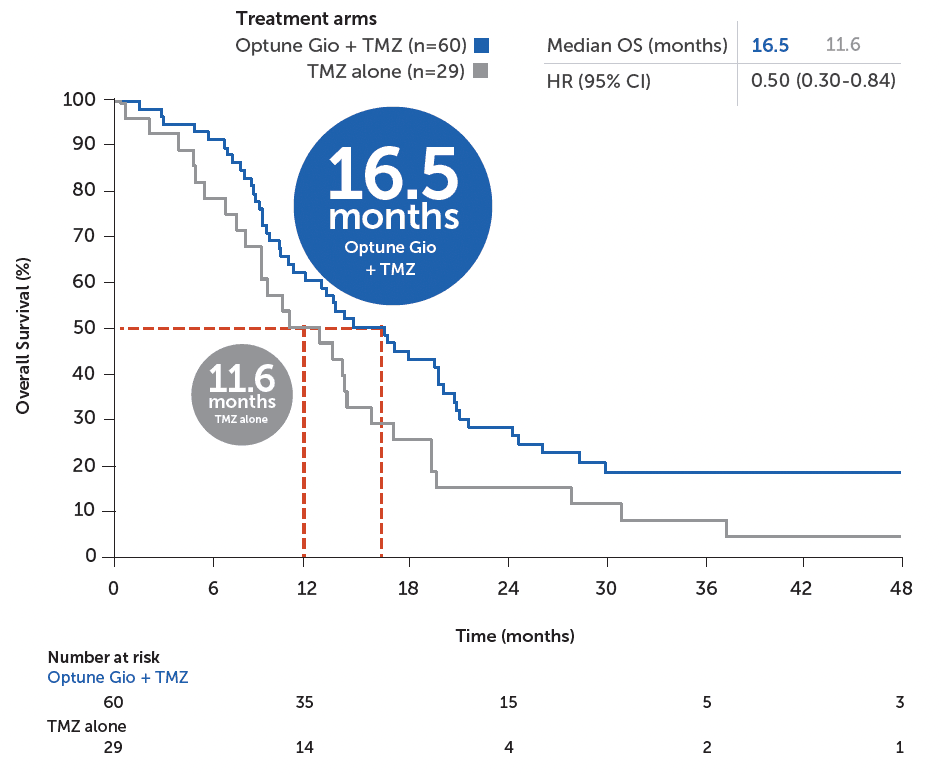
A treatment with minimal impact on patients’ quality of life
QoL was maintained over 12 months in patients treated with Optune Gio + TMZ2,23,25
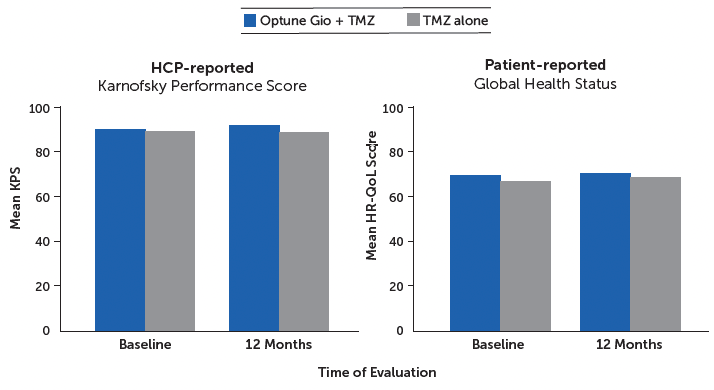
”Many people in the Optune [Gio] community remain active, working, biking, hunting, etc, while wearing the device, so it is possible to not allow it to be ‘invasive,’ but each of us has our own sensitivities, so the main thing is you make the choice that is right for you.”
—Caregiver (American Tumor Association forum)
Optune Gio + TMZ may give your patients the opportunity to extend survival without negatively impacting their daily activities, compared with TMZ alone
The flexibility to choose their treatment time
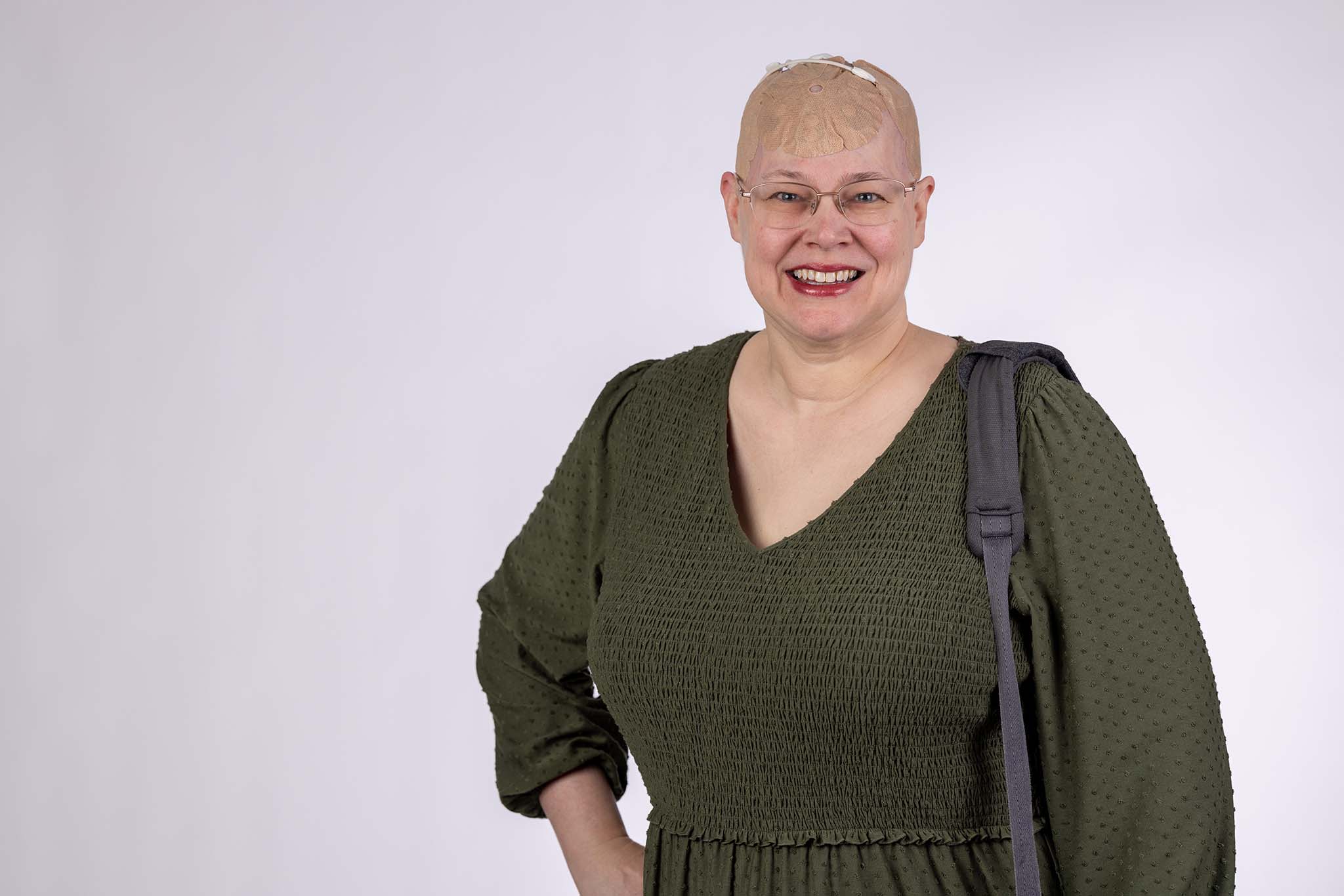
Jeanneane is an Optune Gio user and Patient Ambassador. Patient images reflect the health status of the patient at the time each photo was taken.
Patients may “bank hours”—wearing the device more on some days and less on others—as long as they average 75% of the month using the device.12
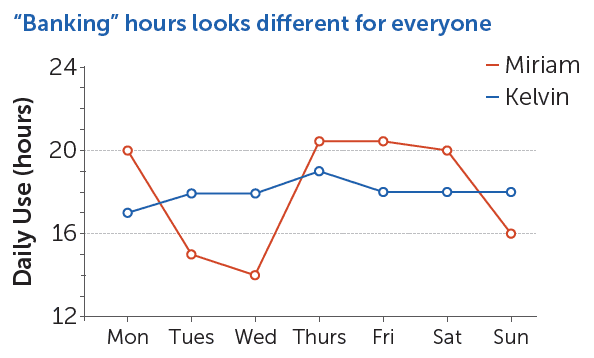
Encourage a routine: Upfront, it can help to set a goal of 30, 60, or 90 days in which they commit to exploring their comfort zones
- The recommended time for using Optune Gio is 18 hours a day
- Kelvin and Miriam took different approaches to making Optune Gio work for them
- Miriam wore Optune Gio extra hours over the weekend because she had a business trip midweek
- Kelvin wore Optune Gio for roughly the same number of hours each day
- Both patients averaged 18 hours/day over the course of the week shown
With Optune Gio, patients can control their GBM treatment on their terms
Optune Gio did not add systemic side effects during the EF-14 trial
There were no significant increases in serious AEs compared with TMZ alone, and no late-emerging serious AEs were seen in the 5-year follow-up1,3
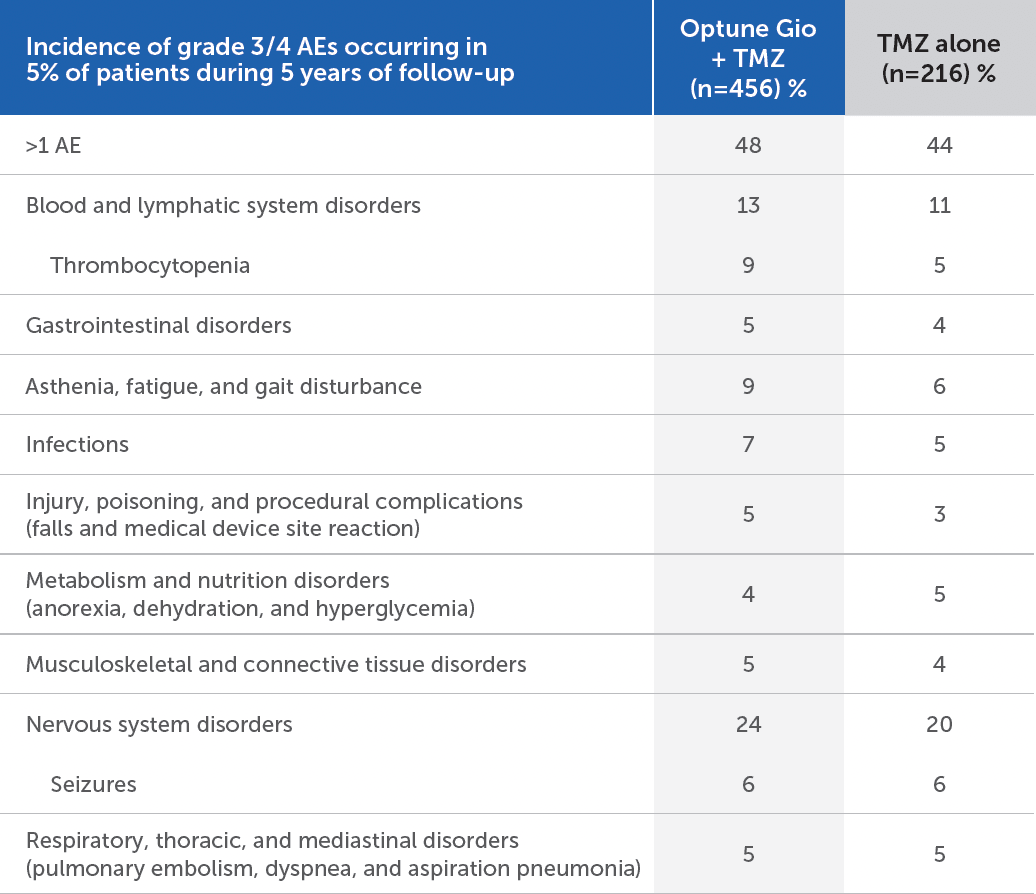
The only device-related AEs from the clinical trial were skin related
- Mild-to-moderate skin irritation, the most common device-related side effect with Optune Gio, was typically manageable, reversible, and did not result in treatment discontinuation26
- The rate of grade 1/2 medical device site reaction was 52% for Optune Gio + TMZ compared with 0% for TMZ alone, and severe (grade 3) skin involvement occurred in 2% of patients treated with Optune Gio + TMZ3
- Grade 3/4 AEs were well balanced between arms. None of the systemic grade 3/4 AEs were considered related to Optune Gio by any of the investigators1
The M3 approach to managing dAEs can help extend time on treatment12
While dermatologic AEs (dAEs) can be common for patients using Optune Gio, you can help maximize time on treatment by getting ahead of them with the M3 approach
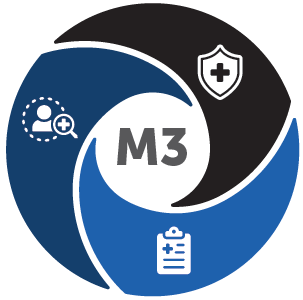
Mitigate by prepping12,27:
- Clean the scalp before shaving and make sure to clean the electric razor per the manufacturer’s guidelines after every shave
- Apply mineral oil before shaving to cleanse the skin and help remove bacteria and scale
Monitor symptoms12
- Tell your patient to report any redness, rash, or itching as soon as possible
- Encourage patients to report and keep a photographic diary of any skin problems
Manage with proper treatment12
- Depending on skin diagnosis, recommended treatments typically include topical antibiotics or topical corticosteroids
*Approximation, based on percentage of usage.
†Vs TMZ alone.
‡Based on the amount of time Optune Gio was turned on and providing therapy over the course of a month. These data reflect the average patient usage of Optune Gio for the first 6 months of treatment (months 1-6).21
§A randomized, open-label trial in 695 patients with newly diagnosed GBM whose tumor was resected or biopsied and who had completed concomitant radiochemotherapy.
2L, second line; GBM, glioblastoma; ndGBM, newly diagnosed glioblastoma; RT, radiation therapy; SRS, stereotactic radiosurgery; TMZ, temozolomide. KPS, Karnofsky Performance Score; OS, overall survival; PFS, progression-free survival; PFS6, progression-free survival at 6 months; QoL, quality of life; MGMT, O-6-methylguanine-DNA methyltransferase; AEs, adverse events; SAEs, serious adverse events; HCP, healthcare provider; HR-QoL, health-related quality of life; GI, gastrointestinal.